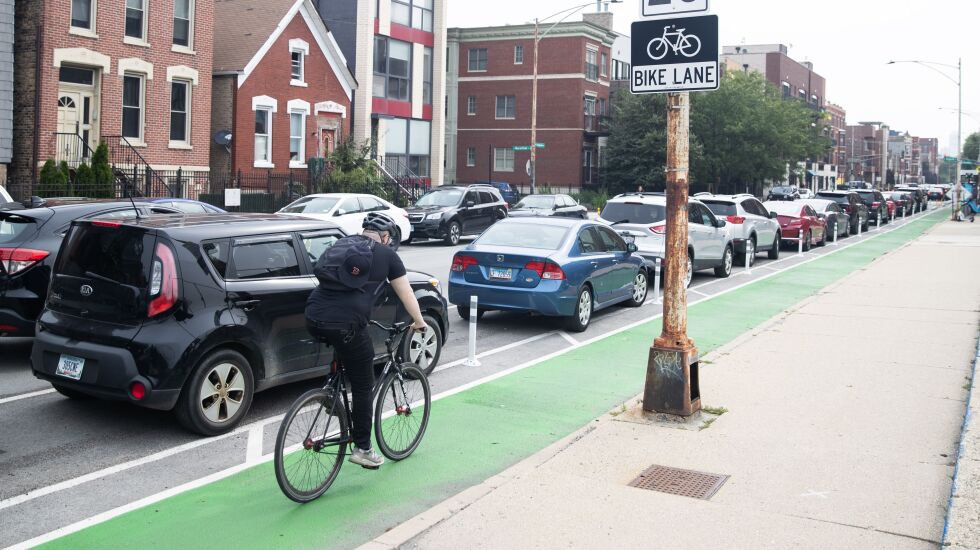
Crews have completed a three-month upgrade to bicycle lanes and pedestrian crossings on Augusta Boulevard in West Town and Ukrainian Village.
Bike lanes no longer border traffic lanes between Western and Milwaukee avenues. To improve safety, bike lanes were moved between parking spaces and the curb.
Speed limits were lowered from 30 mph to 20 mph, and pedestrian crossings were shortened. Construction began in May.
A dozen members of the bicyclist safety advocacy group Bike Lane Uprising have responded, mostly positively, to the new lanes on Augusta, group founder Christina Whitehouse said.
One of Augusta Boulevard’s most serious problems was bike lane obstructions and double parking outside schools and car washes, Whitehouse said.
“We’re hoping this redesign will help alleviate a lot of that,” she said.


Outgoing Transportation Commissioner Gia Biagi said the project creates a safer corridor for everyone: “For cyclists, for pedestrians, for people in their vehicles.”
Most notably, lowering the speed limit to 20 mph will save lives, Biagi said at a news conference Wednesday at Wells Community Academy High School.
Speed is the biggest factor in fatal crashes, she said. A person hit by a car traveling 35 mph is five times more likely to die than someone hit at 20 mph.
The lower speed limit on Augusta Boulevard is already affecting people’s driving habits, she said. Preliminary data show that the number of drivers going faster than 30 mph has dropped 35%; the number of drivers keeping below 20 mph has increased 29%.
Many sidewalk extensions, known as bump-outs, at intersections are merely painted on the road, and several bike lanes are protected by flexible posts. The city will evaluate which posts and bump-outs can be replaced with hardened concrete over the next few months, Biagi said. That has been the city’s process at other sites where bike lanes were upgraded around town, including Milwaukee Avenue, she said.
First Ward Ald. Daniel La Spata, chair of the Committee on Pedestrian and Traffic Safety, said the Augusta project created a long bike corridor that was uncommon four years ago, when the city’s “network of protected bike lanes were hot spots that didn’t really make sense.”
La Spata acknowledged that aldermanic prerogative, where local alderpersons have the final say over projects in their ward, has contributed to the city’s inconsistent bike infrastructure.
“If you ride down Milwaukee Avenue, even over the course of 2 miles, you can go from a dashed line, to a striped line to no line, to a protected bike lane,” said La Spata, who arrived at Wednesday’s news conference on a bicycle.
“So we need collaboration, we need cooperation,” he said. “But I think over the course of the next few years, we also need to consider and perhaps challenge how aldermanic prerogative either facilitates or constrains contexts like that.”

Residents who spoke at a 2022 community meeting on the Augusta Boulevard project said they were concerned about high vehicle speeds, double parking outside schools, dangerous pedestrian crossings and “concerns about bicycle interactions with cars.”
In the meeting, city officials said the stretch of Augusta between Western and Milwaukee had seen hundreds of crashes between 2016 and 2020: 441 total crashes, 92 with injuries and two fatal crashes. Most of the bicycle crashes were at Augusta and Damen Avenue and near Augusta and Milwaukee.
The city has seen drops in crashes after implementing similar upgrades as part of the Chicago Complete Streets program, an outgrowth of a city policy from 2006 that aimed to improve safety of streets for pedestrians, cyclists and drivers.
The Chicago Department of Transportation cited a 56% decrease in crashes on Milwaukee Avenue south of California Avenue where the city had installed curb barriers and similar safety improvements.
The question now, Whitehouse asked, is how the city will improve bike safety west of Western Avenue.
The city has planned or started work on improved bike lanes on Belmont Avenue, Clark Street, Central Park Avenue, Lake Street and Milwaukee Avenue. Biagi, who leaves her post Friday, has said the city had installed 100 miles of bike lanes in the last four years.
“These design modifications are not necessarily winning awards, but things were very bad before,” Whitehouse said. “But honestly, everyone’s expectations of bike lane infrastructure is so low, you could give us anything, and we’d be ecstatic.”







